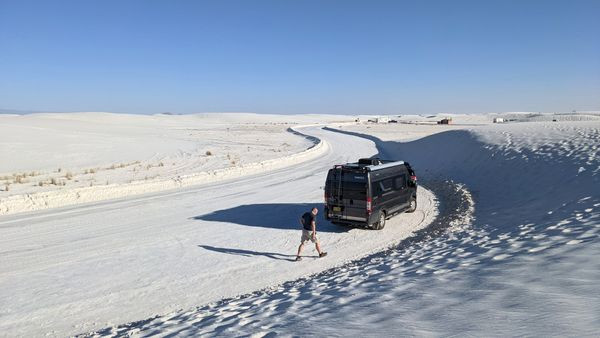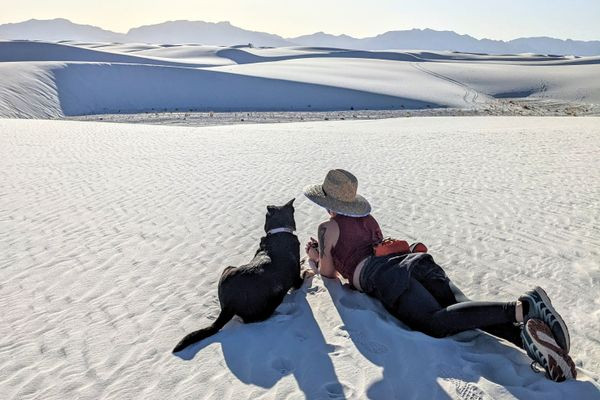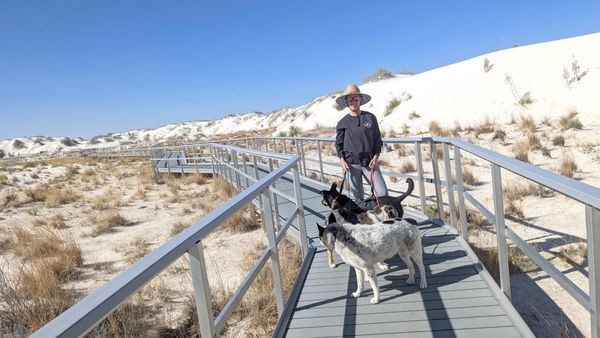White Sands National Park, a shimmering landscape of gypsum dunes in the heart of New Mexico, had been a dream destination for us since we embarked on our RV travels back in 2017. Becoming New Mexico residents in 2019 only intensified the call to explore this unique natural wonder. For our first van adventure of 2022, we finally set course for Southern New Mexico to witness the world’s largest gypsum dunefield firsthand. While the journey included stops at quirky roadside attractions like the World’s Largest Pistachio, charming towns like Cloudcroft, and awe-inspiring Carlsbad Caverns, White Sands was the undeniable highlight. Let us share our experience and guide you through planning your own unforgettable visit to White Sands National Park.
Planning Your White Sands Adventure
Two key factors shaped our White Sands itinerary: weather and the intriguing possibility of missile testing. Yes, you read that right! White Sands National Park shares a border with the White Sands Missile Range, a testing facility that occasionally necessitates park closures for safety. While the National Park Service typically receives a two-week heads-up about scheduled tests, sometimes notice can be as short as 24 hours. Therefore, it’s crucial to check the official park closures page before your visit and even have a flexible backup plan in case of unexpected closures.
Regarding weather, Southern New Mexico lives up to its desert reputation – it gets HOT, especially in the summer months. Traveling with our three dogs meant we prioritized cooler temperatures, opting for a spring visit shortly after de-winterizing our van. Early April proved mostly pleasant, though perhaps a touch earlier in the spring would have been ideal. The surprisingly cool nature of the white gypsum sand underfoot mitigated the warmth, making it comfortable for our furry companions. However, wind was a more significant factor during our visit, so be prepared for potentially breezy conditions, particularly in the afternoons.
Exploring Dunes Drive and Beyond
The White Sands National Park Visitor Center is your essential first stop and the last point to replenish your water supplies. Make sure you’re well-hydrated before venturing deeper into the park. Don’t forget to capture a classic photo at the park sign – a must-do for any visitor!

The main artery through the park is Dunes Drive, an eight-mile scenic road that progressively immerses you into the heart of the white dunes. The initial stretch is paved, leading you past the Interdune Boardwalk. Shortly after, the pavement gives way to packed sand – a surreal sensation for anyone accustomed to driving on solid ground. Growing up around snow, driving on sand felt wonderfully bizarre and exciting!
We drove the entire length of Dunes Drive to its terminus, parking to begin our exploration on foot. You have the freedom to choose between designated trails or simply wander off-trail, ascending the dunes and forging your own path. We opted for the latter, eager to immerse ourselves directly into the dune landscape.

Even a short walk of just a quarter to half a mile into the dunes rewarded us with breathtaking panoramic sunset views. The undulating white landscape stretching to the horizon is truly mesmerizing, especially as the setting sun paints the dunes in soft hues.
For visitors with dogs, White Sands National Park is remarkably dog-friendly, though leashes are mandatory. Our dogs instantly caught the zoomies upon feeling the sand between their paws, resulting in some initial leash-tangling chaos, but they eventually settled into the serene environment.

They quickly adapted to the tranquil pace of dune exploration, alternating between basking in the views and people-watching distant figures cresting dunes. The incredibly fine, white sand had an amusing effect on our black dog, Delta, transforming his fur into something resembling a powdered donut by day’s end!

We briefly considered an early morning hike on the Alkali Flat Trail, a more strenuous 5-mile trek with no shade. However, given our dogs’ contentment with their shorter dune walk and subsequent nap, we opted for a less demanding morning. For more energetic dogs and hikers, the Alkali Flat Trail offers a longer and more immersive dune experience, marked periodically to guide your way.

As dusk approached, we reluctantly began our trek back to the van, savoring the last moments of the stunning White Sands sunset.
Discovering Dune Life and Boardwalk Views
The following morning, we started with the Dune Life Nature Trail, an easy and educational one-mile loop. Informational signs along the path highlight the surprising array of animal life that thrives in this seemingly barren landscape. While we didn’t spot any actual creatures, tracking animal prints in the sand and admiring the resilient plants and trees adapted to this unique environment proved fascinating.

Next, we explored the Interdune Boardwalk, a short, 0.4-mile elevated walkway. This accessible trail is perfect for visitors with mobility concerns, offering a stable, paved path through the dunes, complete with shade structures and benches. The boardwalk took us less than 20 minutes to complete, providing a different perspective of the dune environment from an elevated vantage point. The slatted composite material of the boardwalk planks was a novel experience for our youngest dog, Delta, who nervously hopped off into the dunes after a few steps! If you’re introducing your dog to similar surfaces, bringing treats and offering positive reinforcement is a great strategy.
We decided to forgo the Playa Trail, which appeared less visually diverse compared to the other trails, and unfortunately missed the ranger-led Sunset Stroll, which sounded like a fantastic experience. We often leave a few things “undone” at destinations, giving us compelling reasons to return and explore further.


Where to Stay Near White Sands
For those who, like us, prefer boondocking, Lake Holloman Recreation Area is an excellent and conveniently located option for visiting White Sands National Park. Located just a 5-minute drive from the park entrance, it’s a popular choice for RVers. Despite its popularity, we easily found a spot. Be mindful of the narrow entrance gate if you have a larger RV. It’s essential to note the signs upon entering – while the water may look inviting, Lake Holloman is a wastewater evaporation pond for the nearby military base. Keep your dogs away from the water! Our water-loving dog, Mushy, required careful parking to avoid temptation.
For RV maintenance, a free dump station is available in Alamogordo. Potable water can be a bit harder to source in this desert region. Paid dump and fill services are available at Edgington RV Park and Artesia RV Park. And if you’re heading east after your White Sands visit, the otherworldly Carlsbad Caverns National Park is only a 3.5-hour drive – a highly recommended next stop!
For more incredible dog-friendly sand dune adventures, consider exploring Great Sand Dunes National Park in Colorado. But for a truly unique and unforgettable experience, White Sands National Park in New Mexico is a must-visit destination.
